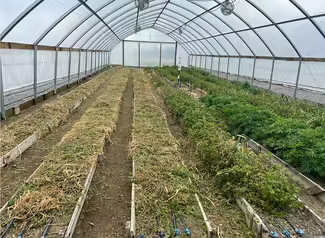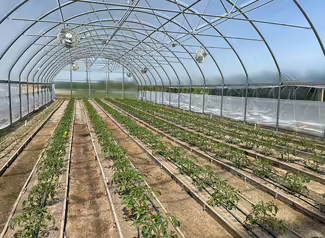
Crops are responding to warm spring temperatures and increased daylength. The crimson clover cover crop began flowering on March 29 and by April 3 was in full flower and ready to be terminated. In our current research project, “Strategies for Improving Biological Control of Insect Pests for Vegetable Growers Utilizing High Tunnels”, one the treatments or strategies is establishing cover crops in the fall after tomato harvest, overwinter the cover crops, and then terminate ahead of transplanting in the spring. The role of the cover crops in the project is to provide a habitat for beneficial insects. In both years of this project, the crimson clover has been infested with a legume specific aphid. In preparing to terminate the cover crop on April 3, a significantly large number of lady beetles in all stages of development, from eggs to adults, were observed, apparently feasting on the aphid food source within the high tunnel. After termination (using a weedeater), tomato transplants were set out on April 9 and 10, and within a couple of days, lady beetle nymphs and adults were observed on those plants, albeit in far less numbers. Pepper transplants were set out on April 15 and 17.
Caterpillar feeding was observed on a few of the tomato transplants within the first week after planting. In order to avoid the feeding damage on early fruit that was seen last season, a Bt spray has already been applied and will be applied weekly. This is a good reminder of the importance and timeliness of crop scouting.
As the transplants have now been growing in the high tunnels for almost 3 weeks, a noticeable difference in growth and color can be seen between the two tunnels. Transplants in the control tunnel with no cover crop are growing more quickly, have a darker green color, and a wider leaf spread compared to the treatment tunnel. Transplants following the cover crop in the treatment tunnel have thinner stems, less leaf spread, and are a paler green in color. At this point, both tunnels have received the same amount of fertilizer.
Broccoli, cauliflower, cabbage, kale, and swiss chard are continuing to grow well in the caterpillar tunnel under 30% shade cloth. It will be interesting to see if the holes in the shade cloth mess are small enough to keep out the common brassica pests like diamondback moth, imported cabbageworm or cabbage white, and cabbage looper.
Hydroponic strawberries have been growing for about a month in the vertical stack system within the high tunnel. The stacks at DSAC are 5 cubes (white Styrofoam) high and each cube holds 4 plants, one in each corner of the cube, giving a total of 20 plants per stack. Perlite is used as the substrate or media within the cubes. ‘Albion’ and ‘San Andreas’ are a few days ahead of ‘Monterey’ in terms of fruit ripening. Harvest has begun on both varieties. Fruit size is similar on both and the general consensus among the crew is that ‘San Andreas’ is sweeter and has a better flavor.



